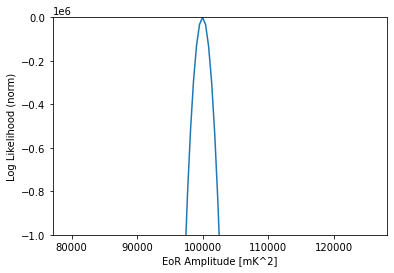Getting Started With pspec_likelihood#
In this tutorial, we will introduce how to use pspec_likelihood as a library. We will cover the different classes you will interact with, how to create a data interface from a UVPSpec object, and how to calculate likelihoods.
[1]:
from hera_pspec import UVPSpec
import numpy as np
# import hera_pspec as hp
# from collections import OrderedDict as odict
# from hera_pspec import utils
# from hera_pspec import uvpspec_utils as uvputils
from astropy import cosmology
import matplotlib.pyplot as plt
from astropy import units as un
from astropy.cosmology import units as cu
import pspec_likelihood as pl
[3]:
path_to_uvp = '../../dvlpt/' #path to pspec files, in ./dvlpt
The layout of the package#
In pspec_likelihood, the idea is to be able to define a data likelihood given some measured (or mock) power spectra. To do this, you will need to define two objects:
A
DataModelInterface: An object that holds the data and theory models and knows how to do basic operations on them (like spherically average and apply window functions).A
PSpecLikelihood: this defines the statistical likelihood based on the model and data. There are a number of these classes, each corresponding to a different set of statistical models.
Defining the theoretical model#
Our first goal is to define the theoretical model. In this tutorial, our data comes from the H1C IDR3 Validation simulation, for which we know the input EoR power spectrum is a simply power-law. We simply define a function that computes the model in the following format:
[4]:
def theory_model(z: float, k: np.ndarray, params: list[float]) -> np.ndarray:
amplitude, index = params
return k**3/(2*np.pi**2)*amplitude * un.mK**2 *(1.+z)/k ** index
Notice that the function must take exactly three parameters: the redshift, the wavenumbers and a list of parameters. It should output an array of the same shape as k, representing the \(\Delta^2(k)\) values in units of \({\rm mK}^2\).
For us, this is simple. For more complicated theoretical models, for instance those that compute entire simulations, this function may itself need to call some other functions, whose output might not actually depend on the k given (i.e. the output wavenumbers might be set by the size of the simulation). In these cases, the theory model function should do some kind of interpolation to yield the model at the input k.
Define the DataModelInterface.#
There are two main ways to define the main DataModelInterface object. You can use the basic class constructor, to which you need to pass all of the relevant data (power spectrum, window function, k-bins, covariance, etc.). However, if your data is in the format of a PSpec object, you can simply use the DataModelInterface.from_uvpspec method.
First, read in the data with UVPSpec:
[5]:
field = 'C'
spw = 0
filename = f'{path_to_uvp}sph_xtk_idr3_field{field}_band{spw+1}.hdf5'
# spherically averaged power spectrum
sph_pk = UVPSpec()
sph_pk.read_hdf5(filename)
[6]:
dmi = pl.DataModelInterface.from_uvpspec(
uvp=sph_pk,
set_negative_to_zero = False,
theory_uses_spherical_k = True,
theory_model=theory_model,
theory_uses_little_h = True,
)
In the above, we do two main things: set the data by giving the UVPSpec object, and set the theory via the theory_model parameter. There are many other parameters that can be given, and we will talk about some of them later. A few deal with how the theory function behaves (eg. whether the theory function expects wavenumbers to be given in units with little h, and whether it requires spherical k values). We can also pass a cosmology to use.
Another parameter that can be passed is a sys_model that computes bias from systematics, given some parameters. Here, we do not use an explicit systematic model.
Now that we have the object, we can plot both the data itself and a model:
[7]:
plt.errorbar(dmi.kpar_bins_obs.value, dmi.power_spectrum.value, yerr=np.sqrt(np.diag(dmi.covariance.value)), lw=0, marker='o', ms=5, capsize=1, capthick=1, elinewidth=1, )
plt.plot(dmi.kpar_bins_obs.value, dmi.compute_model([2e5, 2.7], []).value)
plt.yscale('log')
plt.ylim(1e2, 1e7)
[7]:
(100.0, 10000000.0)
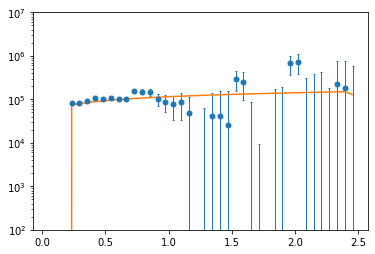
Notice here that the model is computed by giving two lists of float parameters. The first is the theory parameters, and the second are the systematics parameters (of which we have none).
Creating the Likelihood#
Even though we have specified a model for the power spectrum itself, we have not yet specified a statistical likelihood of the data given that model. There are a number of different choices that can be made here. The simplest idea would be to say that the model residuals (to both theory and systematics) are drawn from a multivariate normal distribution. However, if there are many different systematics parameters, sampling over this space can become inefficient. If some of the systematics parameters are linear, then we can do a bit better by analytically marginalizing over them. Further performance benefits can be gained if the covariance is assumed to be diagonal. Given all these considerations, we provide different classes for different kinds of likelihood.
Here, we will use two such likelihoods:
[9]:
like = pl.MarginalizedLinearPositiveSystematics(model=dmi)
likeg = pl.Gaussian(model=dmi)
/home/steven/work/hera/pspec_likelihood/src/pspec_likelihood/likelihood.py:659: UserWarning: Your covariance matrix is not diagonal. The MarginalizedLinearPositiveSystematics class requires diagonal covariance. Forcing it...
warnings.warn(
Each likelihood must be given the DataModelInterface object via the model parameter. Some likelihoods also take other parameters, which you can find out in their documentation.
The first likelihood we defined here is the same as that used for H1C (both IDR2.1 and IDR3). It is a likelihood in which each k-bin is assumed to have a positive systematic component that is equally likely to be any positive number, and is not correlated with other k-bins.
The second likelihood is the simplest multivariate Gaussian, assuming no systematics at all (note that the assumption of no systematics is not intrinsic to the Gaussian likelihood, but rather is because we gave no sys_model to the DataModelInterface).
These likelihood classes expose one useful method: loglike(theory_params, sys_params) -> float, which computes the log-likelihood the data given the theory and systematic parameters. This function is intended to be used in either Bayesian sampling or maximum-likelihood/posterior techniques to either sample the posterior or find the a point-estimate of the parameters.
Note
We do not provide a sampler in pspec_likelihood. That is up to the user to provide. We simply provide a method for calculating the likelihood.
In this case, we know that the “correct” values for the theory parameters are about \(A = 2e5 {\rm mK}^2\) and \(\gamma=2.7\). We build an array around each of these values, and compute the log-likelihood at each:
[10]:
amp = np.logspace(3, 7, 100)
likes = np.zeros(amp.shape)
likes_g = np.zeros(amp.shape)
for i, a in enumerate(amp):
likes[i] = like.loglike([a, 2.7], [])
likes_g[i] = likeg.loglike([a, 2.7], [])
/home/steven/work/hera/pspec_likelihood/src/pspec_likelihood/likelihood.py:679: UserWarning: Warning: Ignoring data in positions (array([0, 1, 2]),) as the variance is zero
warnings.warn(
/home/steven/work/hera/pspec_likelihood/src/pspec_likelihood/likelihood.py:612: UserWarning: Warning: Ignoring data in positions (array([0, 1, 2]),) as the variance is zero
warnings.warn(
/home/steven/work/hera/pspec_likelihood/src/pspec_likelihood/likelihood.py:699: RuntimeWarning: divide by zero encountered in log1p
np.log1p(erf(residuals_over_errors)),
[11]:
indx = np.linspace(1, 3, 100)
likes_indx = np.zeros(indx.shape)
likes_g_indx = np.zeros(indx.shape)
for i, a in enumerate(indx):
likes_indx[i] = like.loglike([2e5, a], [])
likes_g_indx[i] = likeg.loglike([2e5, a], [])
Now we can plot the resulting log-likelihoods as a function of these parameters:
[12]:
plt.figure(figsize=(8,6), dpi=300)
plt.plot(amp, likes - likes.max(), label='IDR3 Likelihood')
plt.plot(amp, likes_g - likes_g.max(), label='Gaussian Likelihood')
plt.xscale('log')
plt.ylim(-1000, 0)
plt.xlabel("Amplitude [mK^2]")
plt.ylabel("Log Likelihood (norm)")
plt.legend()
[12]:
<matplotlib.legend.Legend at 0x7f2ebcd61e70>
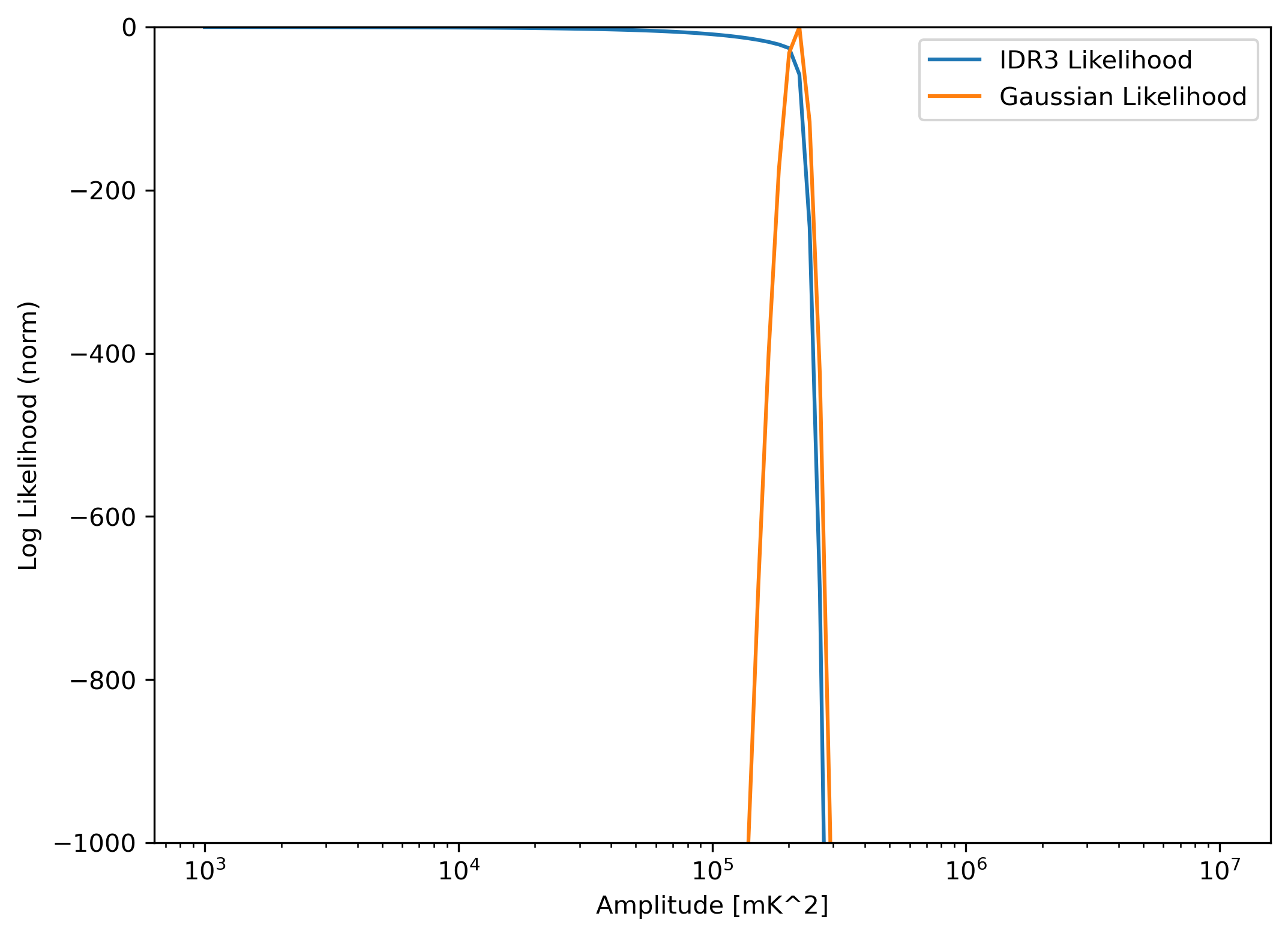
[15]:
plt.figure(figsize=(8,6), dpi=300)
plt.plot(indx, likes_indx - likes_indx.max(), label='IDR3 Likelihood')
plt.plot(indx, likes_g_indx - likes_g_indx.max() , label='Gaussian Likelihood')
plt.xscale('log')
plt.ylim(-1000, 0)
plt.xlabel("Power-Law Index")
plt.ylabel("Log Likelihood (norm)")
plt.legend()
[15]:
<matplotlib.legend.Legend at 0x7f859676e0b0>
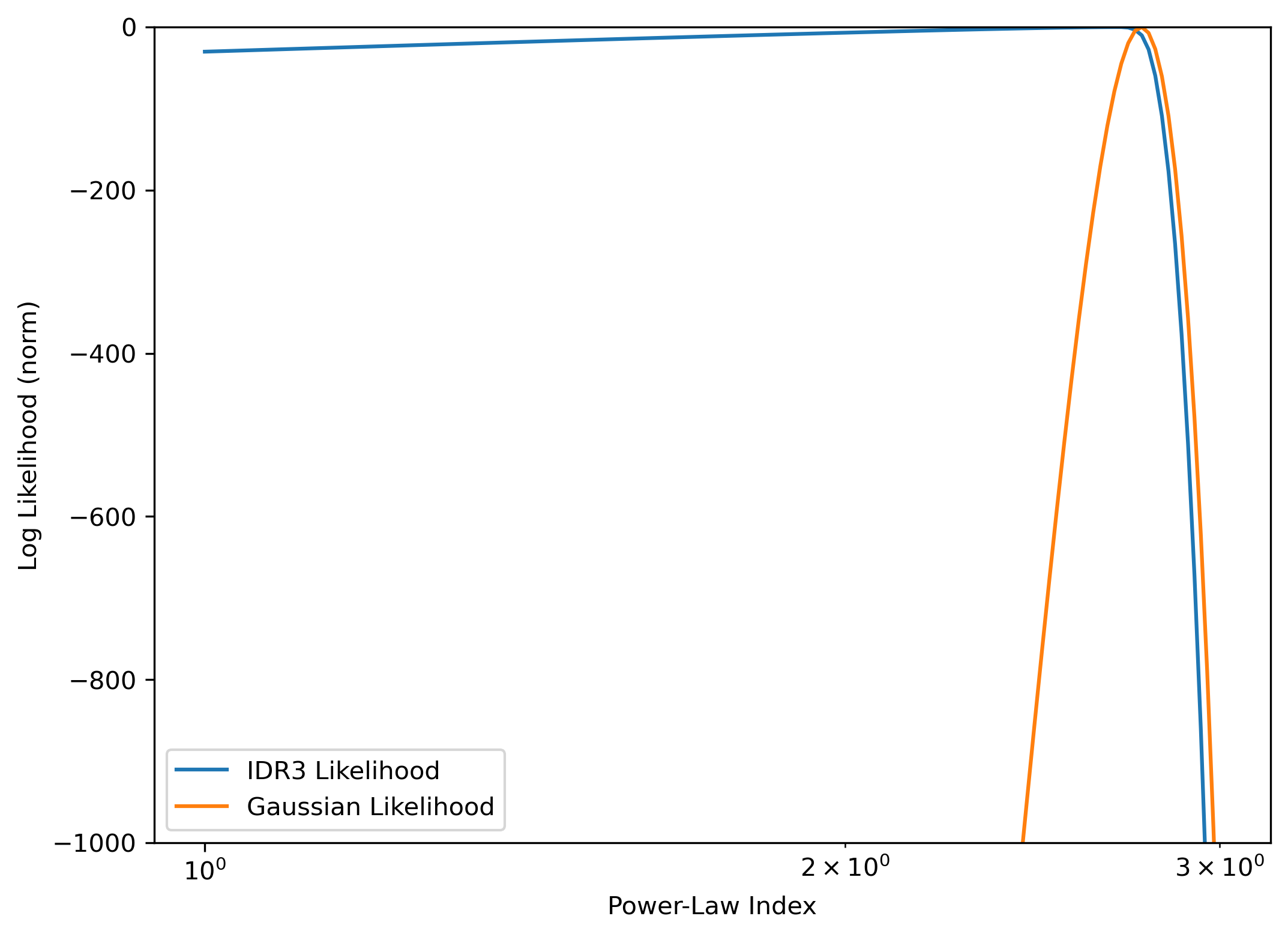
Clearly, the maximum likelihood is at the known correct parameters, for the Gaussian likelihood. For the H1C likelihood, any model which gives a power significantly lower than the data estimate has essentially equivalent likelihood value. This is because this likelihood is essentially treating the data as an upper limit by assuming the systematics may make up any portion of the power.
Creating a DataModelInterface without a UVPSpec object.#
If you don’t have a UVPSpec object, you can create a DataModelInterface from scratch. This makes it easier to mock up data for testing, or to read data from a different source.
In the examples below, we create DataModelInterface objects of three different types with the standard constructor. Each has a different mix of whether the data is in spherical/cylindrical space, and whether the theory model is computed in spherical/cylindrical space.
Spherical Data, Spherical Theory#
Let’s create a mock power spectrum that is already in spherical coordinates:
[13]:
k = np.linspace(0.01, 0.5, 100)
z = 9.0
amp, indx = 1e5, 2.7
power = k**3/(2*np.pi**2)*amp * un.mK**2 *(1.+z)/k ** indx
covariance = np.diag(k**3 * 1e5)
window_function = np.eye(len(k))
Then we can define our DataModelInterface like so:
[14]:
dmi = pl.DataModelInterface(
cosmology=cosmology.Planck18,
redshift=z,
power_spectrum=power,
window_function=window_function,
covariance=covariance*un.mK**4,
kpar_bins_obs=k * cosmology.units.littleh / un.Mpc,
theory_uses_little_h=True,
theory_uses_spherical_k=True,
theory_model=theory_model,
)
Notice here that we define kpar_bins_obs and not kperp_bins_obs. If you pass only kpar, then it will be interpreted as spherical k.
[27]:
like = pl.Gaussian(model=dmi)
amps = np.logspace(4.9, 5.1, 101)
likes = np.array([like.loglike([a, indx], []) for a in amps])
plt.plot(amps, likes - likes.max())
plt.ylim(-1000000, 0)
plt.xlabel("EoR Amplitude [mK^2]")
plt.ylabel("Log Likelihood (norm)")
[27]:
Text(0, 0.5, 'Log Likelihood (norm)')
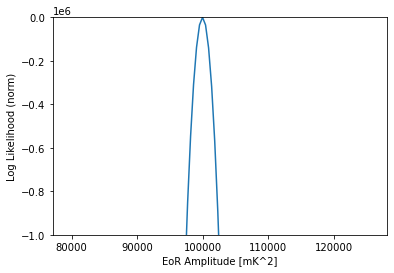
Cylindrical Data, Spherical Theory#
Suppose we have data that is in cylindrical co-ordinates. We can use this data, even if our theory model is purely spherical. Let’s create some mock power spectrum data whose power is intrinsically only dependent on \(|k|\), but which is in cylindrical coordinates:
[28]:
kperp = np.linspace(0.01, 0.5, 15)
kpar = np.linspace(0.01, 0.5, 100)
KPERP, KPAR = np.meshgrid(kperp, kpar)
KPERP = KPERP.flatten()
KPAR = KPAR.flatten()
k = np.sqrt(KPAR**2 + KPERP**2)
z = 9.0
amp, indx = 1e5, 2.7
power = theory_model(z, k, [amp, indx])
covariance = np.diag(k**3 * 1e5)
window_function = np.eye(len(k))
dmi = pl.DataModelInterface(
cosmology=cosmology.Planck18,
redshift=z,
power_spectrum=power,
window_function=window_function,
covariance=covariance*un.mK**4,
kpar_bins_obs=KPAR * cosmology.units.littleh / un.Mpc,
kperp_bins_obs=KPERP * cosmology.units.littleh / un.Mpc,
theory_uses_little_h=True,
theory_uses_spherical_k=True,
theory_model=theory_model,
)
Note here that the theory model given is still the spherical one. However, we give both kperp and kpar, which are arrays of the same length (i.e. they are not assumed to be a rectilinear grid).
[29]:
like = pl.Gaussian(model=dmi)
amps = np.logspace(4.9, 5.1, 101)
likes = np.array([like.loglike([a, indx], []) for a in amps])
plt.plot(amps, likes - likes.max())
plt.ylim(-1000000, 0)
plt.xlabel("EoR Amplitude [mK^2]")
plt.ylabel("Log Likelihood (norm)")
[29]:
Text(0, 0.5, 'Log Likelihood (norm)')
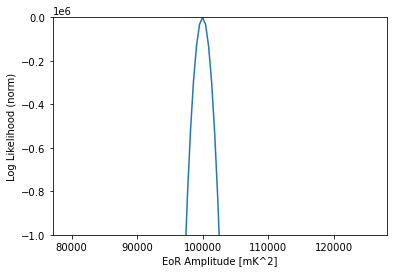
Cylindrical Data, Cylindrical Theory#
Now, if both data and theory are defined in cylindrical space, we can manage that too. The only difference is that the theory model needs to assume that the k argument given to it is really a tuple, (kperp, kpar):
[30]:
def powerlaw_eor_cylindrical(z: float, kcyl: tuple[np.ndarray, np.ndarray], params: list[float]) -> np.ndarray:
amplitude, index = params
kperp, kpar = kcyl
k = np.sqrt(kperp**2 + kpar**2)
return k**3/(2*np.pi**2)*amplitude * un.mK**2 *(1.+z)/k ** index
[31]:
dmi = pl.DataModelInterface(
cosmology=cosmology.Planck18,
redshift=z,
power_spectrum=power,
window_function=window_function,
covariance=covariance*un.mK**4,
kpar_bins_obs=KPAR * cosmology.units.littleh / un.Mpc,
kperp_bins_obs=KPERP * cosmology.units.littleh / un.Mpc,
theory_uses_little_h=True,
theory_uses_spherical_k=False, # <-- this is the important bit
theory_model=powerlaw_eor_cylindrical, # <-- this is the important bit
)
[32]:
like = pl.Gaussian(model=dmi)
amps = np.logspace(4.9, 5.1, 101)
likes = np.array([like.loglike([a, indx], []) for a in amps])
plt.plot(amps, likes - likes.max())
plt.ylim(-1000000, 0)
plt.xlabel("EoR Amplitude [mK^2]")
plt.ylabel("Log Likelihood (norm)")
[32]:
Text(0, 0.5, 'Log Likelihood (norm)')
